May 27, 2016
by Carole Zangari -

We’re ready to tear off another page of the calendar and that means we are preparing for a new set of core words to focus on. Join us in highlighting a set of core words for the month and helping our AAC learners become more fluent in using them on a day-to-day basis, Whether you are following along with the 2013 Year of Core (Set 1-12 words/month) or the 2014 A(nother) Year of Core: (Set 2-16 words/month; Different than the previous year’s core words), or just getting started, here are some helpful resources. Our June words are listed below. Set 1 (2013) List: after, am/be/is, because, can, cold, fast, fun, have, hungry, let, need, talk Set 2 (2014) List: about, back, buy, grandmother, hand, inside, lose, move, okay, people, quiet, short, show, two, water, yellow Templates for you to plug in your own symbols: Set 1 words, Set 2 words... [Read More...]
Filed under: Featured Posts, PrAACtical Thinking
May 23, 2016
by Carole Zangari -

Even veteran clinicians and educators find themselves looking for resources to help others better understand what AAC is and why it may have been recommended in a particular situation. Today, we welcome back SLP Lauren Enders to introduce us to the information she has collected for this purpose. :::::::::::::::::::::::::::::: This month on PrAACtically Pinteresting, we’ll be taking a look at the board AAC: Why Use AAC?/Benefits of AAC. Very often, I am asked if I have resources that can be shared with team members or families who are reluctant to implement AAC. Often this reluctance results from of simple lack of information or beliefs in a variety of myths surrounding AAC use. I created this board to serve as an easily accessible repository of resources that can be shared with parents, professionals, or support staff who are hesitant to use AAC with their child/student/client. The board contains pins with information that... [Read More...]
Filed under: Featured Posts, PrAACtical Thinking
Tagged With: Lauren Enders, Pinterest
May 22, 2016
by Carole Zangari -
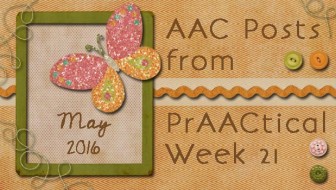
May is Better Hearing and Speech Month, a perfect time to build awareness among colleagues and in the community. Monday – AAC in the Classroom: 5 Presentation Handouts Wednesday – Assessing Barriers to Access for AAC Learners Thursday – Beyond Requesting: A Week of Routines to Increase AAC Use at Mealtime
Filed under: Featured Posts, PrAACtical Thinking
May 19, 2016
by Carole Zangari -
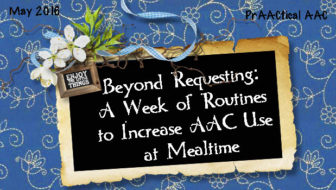
“Waffle.” “I want ___.” “More.” “I’d like a diet coke, please.” “Help.” Most AAC interventionists are quite effective at helping clients use their communication systems during snack or mealtime in order to make requests. How can we move beyond that and help AAC learners communicate for a wider variety of purposes? Mealtimes are wonderful social opportunities and we can take advantage of that by building interaction opportunities around predictable routines. Why build a routine? The predictability helps learners understand what is expected of them. Understanding the expectation sets the stage for active participation. When something becomes a routine, it gets implemented regularly. That gives our learners lots of opportunities to practice their new skills. It also gives us the opportunity to get better at key instructional strategies, such as aided language input, creating explicit opportunities, and using language expansions. Need some suggestions for routines that can be created to foster... [Read More...]
Filed under: Featured Posts, PrAACtical Thinking
Tagged With: meals, requesting, social interaction
May 16, 2016
by Carole Zangari -
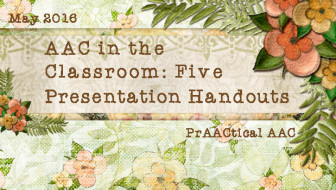
Looking for ideas on how to strengthen language learning by students with AAC needs in the classroom? Here are some presentation handouts that may spur your thinking. Start Talking in Class: Helping Students Using AAC Devices by Gail M. Van Tatenhove Incorporating AAC Use into the Classroom by Karen Vinson and Eleanor Thompson Aided Language Stimulation and the Descriptive Teaching Model by Gail M. Van Tatenhove Communication Peeled and Cored for the Classroom by Jennifer M. Ro and Amy Thomsen Score with Core: Implementing Core Vocabulary in the Classroom by Janet S. Lehr
Filed under: Featured Posts, PrAACtical Thinking
Tagged With: classroom, handouts, school
May 15, 2016
by Carole Zangari -
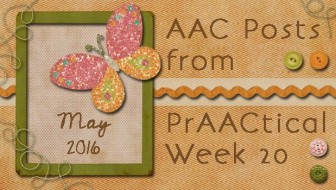
Happy Better Hearing and Speech Month! Monday – AAC Core Vocabulary Instruction: Indirect Teaching Strategies Wednesday – Video of the Week: Assessing Communication Needs in AAC Learners Thursday – PrAACtically Reading with Karen Natoci: The Five Senses
Filed under: Featured Posts, PrAACtical Thinking
May 12, 2016
by Carole Zangari -
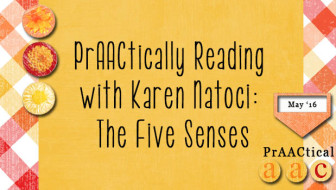
SLP Karen Natoci has always promoted multi-sensory paths to learning. In this month’s installment of PrAACtically Reading, she dives into the topic of our senses, something that is part of many curricula used in special and general education. You can read about her ideas for implementation, see her students’ work, and download the lesson plan and supporting documents in this engaging post. Happy reading! ::::::::::::::::::::::::::::::::::::::::::::::::::::::::::::::::::; PrAACtically Reading with Karen Natoci: The Five Senses Book Series: For students at the emergent reading level: The Five Senses: Touching, by Rebecca Rissman The Five Senses: Smelling, By Rebecca Rissman The Five Senses: Hearing, by Rebecca Rissman The Five Senses: Seeing, by Rebecca Rissman The Five Senses: Tasting, by Rebecca Rissman For learners at the Conventional Reading Level: Hearing, by Sharon Gordon Smelling, by Sharon Gordon Seeing, by Sharon Gordon Touching, by Sharon Gordon Core vocabulary focus: LOOK, SEE, TOUCH, LISTEN/HEAR, GET, THAT, MORE, MY/MINE,... [Read More...]
Filed under: Featured Posts, PrAACtical Thinking
Tagged With: literacy, reading
May 9, 2016
by Carole Zangari -
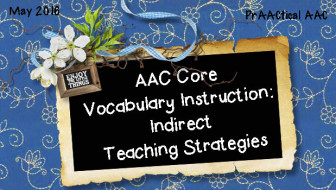
It has been so exciting to see that AAC learners are increasingly provided with communication boards, books, SGDs, and apps that feature a robust set of core vocabulary words. For many years, ‘providing AAC’ used to mean access to topic and choice boards or activity-specific communication displays (ABCDs). Now, we recognize the limitations of those approaches and do our best to move beyond them in favor of more linguistically robust options. AAC systems with core vocabulary that is organized to support the development of a motor plan allows learners to build and grow their skills over time. For a long time, the AAC field has known that providing access to appropriate tools (in this case, a core vocabulary set) is only the first step toward successful use of augmentative communication. Providing it is necessary but not sufficient for most AAC learners to develop any sort of linguistic competence. For... [Read More...]
Filed under: Featured Posts, PrAACtical Thinking
Tagged With: AAC intervention, implementation, language therapy
May 8, 2016
by Carole Zangari -

May is Better Hearing and Speech Month, a perfect time to build awareness among colleagues and in the community. Monday – PrAACtically May: Resources for a Year of Core Vocabulary Words Wednesday – Video of the Week: Increasing Core Vocabulary Use at Home, Therapy, and in School Thursday – AAC Assessment Corner with Vicki Clarke: The Eyes Have It – Assessment Considerations for High Tech Eye Gaze
Filed under: Featured Posts, PrAACtical Thinking
May 5, 2016
by Carole Zangari -
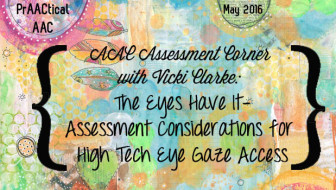
AAC assessment is an area that most professionals struggle with for one reason or another. I am so grateful to Vicki Clarke for returning to share her thoughts on the prAACticalities of conducting these evaluations. If you are looking for tips on assessing someone who needs high tech eye gaze AAC, this post is for you. For other posts authored by Vicki, click here. ::::::::::::::::::::::::::::::::::::::::::::::::::::::::::: The Eyes Have It: Assessment Considerations for High Tech Eye Gaze Access Eye gaze control for AAC device access is a hallmark technological achievement in the world of speech generating devices. For people with significant motor challenges we are no longer limited to scanning as our one choice for AAC access. AAC Specialists have been using light tech eye gaze boards and PVC pipe frames with these friends for years, but now we are able to offer voice output. Eye gaze is for a much... [Read More...]
Filed under: Featured Posts, PrAACtical Thinking
Tagged With: assessment, eye gaze









